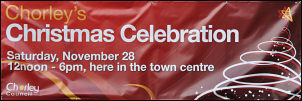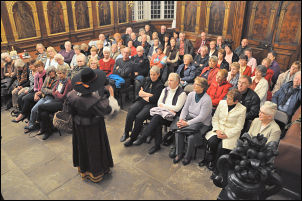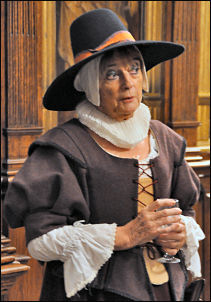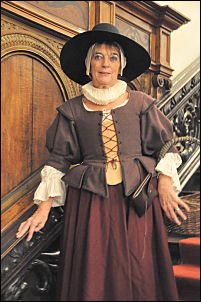|
|
|
Nov 2009 |
|
|
|
Sat 28 Nov 2009
Radio Lancashire live broadcast from Chorley Town Centre. |
|
Radio
Lancashire were in Chorley Town Centre on Sat 28 Nov 09 to help
with the start of the Christmas celebrations and the switching
on of the Christmas lights. Their Saturday morning programme was
partly broadcast live from the town centre and also had the
theme of events of 1974 and in particular the effects of the
local boundary reorganisations which chopped large parts off
Lancashire. |
 |
|

Santa and Chorley's Mayor, Cllr Iris Smith
arrive at the Radio Lancashire stand. |
They asked
Chorley Historical and Archaeological Society to go live and
help with their broadcast. Many thanks to John and Christine
Harrison who were ready at the microphone at 9am.
John gave an excellent explanation of the reasons and effects of
the boundary changes and described many other events during the
year of 1974. When asked who won the Eurovision Song Contest
John came up with the correct answer of Waterloo by Abba but
thankfully declined to sing the intro. |
|
When explaining
the reasons for the boundary changes John drew a fascinating
analogy between population changes in Lancashire with Winston
Churchill and Joseph Stalin planning Europe's postwar (WW2)
reorganization.
Could this broadcast be the start of something new, CHAS-fm?
After the live broadcast John and Christine had to rush off to
attend the 3rd Lancashire Archaeology Day School in Preston.
|

Yalta summit 1945 with Churchill, Roosevelt & Stalin |
|
|
Sat 28 Nov 2009
3rd Lancashire Archaeology Day School, Preston. |
|
A dozen or so
members from Chorley, Leyland and Darwen Societies helped to
swell the numbers at Preston last week, it was quite well
attended. The programme was very varied from ‘The Dunkirk Coal
Pit’ at Read (Brian Jeffrey and Richard Matthews) to ‘The Loos
Trenches’ at Blackpool (Stephen Bull).
The Coal Pit was a drift mine worked by a waterwheel which was
12ft in diameter, with a 6ft diameter cog wheel turning a 12ft
drum. The talk was very explicit, accompanied by slides. Also a
number of artefacts found on the site were displayed to view. ‘
The Loos Trenches’ were training trenches dug in Watson Road
Park Blackpool at the start of WW1. Aerial photos were displayed
and various slides shown of the operations that occurred there.
Holiday makers used to visit the park, as an attraction, at the
time, as the illuminations were ceased when the war started. The
talk was very interesting and full of information. Dot Waring (Darwen
Socy.) gave a very interesting talk about the Society, its
beginnings and involvement with all things local. i.e.
photographs, documents, data basis, digs and oral records, all
of which have been collected for posterity by the members. Dot’s
was an ‘off the cuff’ talk with lots of slides to back up her
information, especially their latest addition, A TOWN CRIER
complete with costume.
There were also speakers on: ‘The Houses of the Douglas Valley
1330-1700 (Gary Miller) certainly knew his stuff. ‘Prehistoric
Pendleton (David Barrowclough) was very interesting as was
‘Historic Lathom’ Part 3 (J. Quartermaine & P. Kenyou) along
with ‘Housing in the 19c Workplace, East Lancs’ (Richard & Carol
Newman), which concluded to make the day very enjoyable and
eventful.
JD |
|
|
Thu 26 Nov 2009
Lizzie Jones at Astley Hall as ‘Ann Hathaway – Will’s Wife’ |
|
Lizzie Jones
made another very welcome return to Astley Hall, Chorley to give
her presentation ‘Ann Hathaway – Will’s Wife’.
Lizzie began be explaining the back ground of the presentation
and how Ann Hathaway is known of widely as the wife of William
Shakespeare and having lived in Ann Hathaway’s cottage, but that
is generally where most peoples knowledge of her ends.
Ann Hathaway's life spans the Elizabethan and Stuart periods
that are a favourite of Lizzie and Ann is one of the 16 women’s
lives in her repertoire. |

A full house listens to Ann Hathaway. |
|
 |
For Lizzie’s
performance as Ann she was dressed in authentic dress of the
time and firstly gave a detailed description of all the items
worn. Even down to the shoes which were not for left or right
feet but worn on either and alternated to keep them ‘universal’.
Anne Hathaway began by introducing herself and that she was
speaking from 1611. William Shakespeare was about to return to
Stratford after being away in London for 20 years. He started
out as an actor and moved on to writing plays and poetry later.
Will was able to make quite a bit of money during his career,
but not from writing. He invested wisely in theatres and so was
able to derive income from the paying audiences. |
|
Ann and Will
were married in 1582 when Ann was 26 and Will just 18. Ann was
already pregnant with their daughter Susanna. Two years later
they had twins Hamnet and Judith. Unfortunately their
descendents didn’t get too far and the Shakespeare line did not
get further that two generations. After the wedding Will spent
most of his time in London but he did retire to Stratford in
1613. Will’s investments enabled him to buy a substantial house
for Ann which is now one of the most photographed buildings in
the country, Ann Hathaway’s cottage.
Will’s retirement didn’t last long. He died in 1616 at the age
of 52, which was considered a good age at the time. Ann survived
him for a further 7 years and she died in 1623 at the age of 67.
She was a countrywoman and could not afford the finery of higher
status, nor would she want to.
Many thanks to Lizzie for bringing Ann Hathaway to Chorley.
B.H. |
|

Ann Hathaway on the main stairs. |

Ann Hathaway by the fire in the Great Hall. |
|
|
Tue 10 Nov 2009
Malcolm Tranter on 'Gardens in the North West' |
This was a very welcome return, albeit sooner than expected, for
Malcolm. His topic was also a radical departure from the
Society’s usual subject matter. Due to the cancellation of
scheduled speakers, 2 had previously been arranged, Malcolm
agreed at short notice, to present a talk on a topic obviously
close to his heart.
And, from the audience’s reaction to his collection of beautiful
images from 16 gardens, the subject matter was also close to
many present.
Our journey started at Bodnant, in the Conway valley. The image
of the laburnum ‘tunnel’, a spectacular spring-time feature, set
the tone for brightening up what had been a typically dull, damp
and cold November day.
|
 |
He then took us east to the Wirral
and to the University of Liverpool’s gardens at Ness. Then
across Cheshire to Dunham Massey, one of the best-known gardens
in the region, then to the little known but aptly named, Dunge
Valley Hidden Gardens. This garden, situated between
Macclesfield and Whaley Bridge, was relatively small but made up
for that in drama in the steep sided valley.
From the mild climate at Churchtown, Southport to exposed spots
high on the Pennine moors, Land Farm, Hebden Bridge, there was a
wide range gardens with a similarly wide range of plant
collections. From the formal, immaculately kept gardens like at
Leighton Hall to seemingly wild places at The Himalayan Garden,
near Ripon, there was something for everyone.
His favourite, apparently, was Holehird. Home to The Lakeland
Horticultural Society, near Windermere. Malcolm left the
beautiful images of the garden in summer and winter, accompanied
by suitably soothing mood music, to speak for him.
A fitting end to a very different evening but no less
interesting for that.
J.D. |
|
|
|